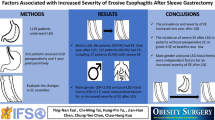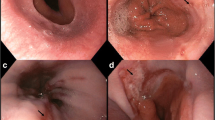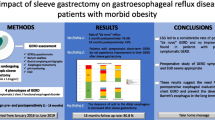Abstract
Background
Although laparoscopic sleeve gastrectomy (LSG) is an effective treatment for morbid obesity, the effects of LSG on gastroesophageal reflux disease (GERD) are controversial. This study evaluated the changes of GERD symptoms and erosive esophagitis (EE) in severely obese patients who underwent LSG.
Methods
Forty-seven severely obese women and 19 severely obese men (mean age of 37.2 ± 12.7 years) who underwent LSG between August 2007 and November 2009 were enrolled. All patients completed the Reflux Disease Questionnaire and underwent esophagogastroduodenoscopy preoperatively and at least 1 year after LSG.
Results
The median follow-up period was 12 months (range, 12–21). After surgery, significant decreases were reported in mean body mass index (36.3 ± 4.1 vs. 25.8 ± 2.9 kg/m2), mean waist circumference (109.5 ± 12.8 vs. 85.7 ± 9.5 cm), and prevalence of metabolic syndrome (54.5 vs. 7.6 %; P < 0.001 for both). Conversely, a significant increase was observed in the prevalence of GERD symptoms (12.1 vs. 47 %) and EE (16.7 vs. 66.7 %) after LSG (P < 0.001 for both). The prevalence of hiatal hernias also increased significantly (6.1 vs. 27.3 %; P < 0.001) after LSG, and it was significantly higher in patients with than those without EE after LSG (9.1 vs. 36.4 %, respectively; P = 0.02).
Conclusions
Although LSG can achieve significant weight loss and improvement of comorbidities in severely obese patients, the prevalence and severity of GERD symptoms and EE increase after the operation. The occurrence of EE after LSG is related to the presence of a hiatal hernia after the operation.

Similar content being viewed by others
References
Dent J, El-Serag HB, Wallander MA, Johansson S (2005) Epidemiology of gastro-oesophageal reflux disease: a systematic review. Gut 54:710–717
Hampel H, Abraham NS, El-Serag HB (2005) Meta-analysis: obesity and the risk for gastroesophageal reflux disease and its complications. Ann Intern Med 143:199–211
Wong BC, Kinoshita Y (2006) Systematic review on epidemiology of gastroesophageal reflux disease in Asia. Clin Gastroenterol Hepatol 4:398–407
El-Serag H (2008) Role of obesity in GORD-related disorders. Gut 57:281–284
Lee YC, Yen AM, Tai JJ, Chang SH, Lin JT, Chiu HM, Wang HP, Wu MS, Chen TH (2009) The effect of metabolic risk factors on the natural course of gastro-oesophageal reflux disease. Gut 58:174–181
Tai CM, Lee YC, Tu HP, Huang CK, Wu MT, Chang CY, Lee CT, Wu MS, Lin JT, Wang WM (2010) The relationship between visceral adiposity and the risk of erosive esophagitis in severely obese Chinese patients. Obesity (Silver Spring) 18:2165–2169
De Groot NL, Burgerhart JS, Van De Meeberg PC, de Vries DR, Smout AJ, Siersema PD (2009) Systematic review: the effects of conservative and surgical treatment for obesity on gastro-oesophageal reflux disease. Aliment Pharmacol Ther 30:1091–1102
Deitel M, Gagner M, Erickson AL, Crosby RD (2011) Third International Summit: current status of sleeve gastrectomy. Surg Obes Relat Dis 7:749–759
Tai CM, Lee YC, Wu MS, Chang CY, Lee CT, Huang CK, Kuo HC, Lin JT (2009) The effect of Roux-en-Y gastric bypass on gastroesophageal reflux disease in morbidly obese Chinese patients. Obes Surg 19:565–570
Chiu S, Birch DW, Shi X, Sharma AM, Karmali S (2011) Effect of sleeve gastrectomy on gastroesophageal reflux disease: a systematic review. Surg Obes Relat Dis 7:510–515
Cottam D, Qureshi FG, Mattar SG, Sharma S, Holover S, Bonanomi G, Ramanathan R, Schauer P (2006) Laparoscopic sleeve gastrectomy as an initial weight-loss procedure for high-risk patients with morbid obesity. Surg Endosc 20:859–863
Moon Han S, Kim WW, Oh JH (2005) Results of laparoscopic sleeve gastrectomy (LSG) at 1 year in morbidly obese Korean patients. Obes Surg 15:1469–1475
Himpens J, Dapri G, Cadiere GB (2006) A prospective randomized study between laparoscopic gastric banding and laparoscopic isolated sleeve gastrectomy: results after 1 and 3 years. Obes Surg 16:1450–1456
Braghetto I, Csendes A, Korn O, Valladares H, Gonzalez P, Henriquez A (2010) Gastroesophageal reflux disease after sleeve gastrectomy. Surg Laparosc Endosc Percutan Tech 20:148–153
Lakdawala MA, Bhasker A, Mulchandani D, Goel S, Jain S (2010) Comparison between the results of laparoscopic sleeve gastrectomy and laparoscopic Roux-en-Y gastric bypass in the Indian population: a retrospective 1 year study. Obes Surg 20:1–6
Carter PR, LeBlanc KA, Hausmann MG, Kleinpeter KP, deBarros SN, Jones SM (2011) Association between gastroesophageal reflux disease and laparoscopic sleeve gastrectomy. Surg Obes Relat Dis 7:569–572
Howard DD, Caban AM, Cendan JC, Ben-David K (2011) Gastroesophageal reflux after sleeve gastrectomy in morbidly obese patients. Surg Obes Relat Dis 7:709–713
Lee WJ, Wang W (2005) Bariatric surgery: Asia-Pacific perspective. Obes Surg 15:751–757
Alberti KG, Eckel RH, Grundy SM, Zimmet PZ, Cleeman JI, Donato KA, Fruchart JC, James WP, Loria CM, Smith SC Jr (2009) Harmonizing the metabolic syndrome: a joint interim statement of the International Diabetes Federation Task Force on Epidemiology and Prevention; National Heart, Lung, and Blood Institute; American Heart Association; World Heart Federation; International Atherosclerosis Society; and International Association for the Study of Obesity. Circulation 120:1640–1645
Shaw MJ, Talley NJ, Beebe TJ, Rockwood T, Carlsson R, Adlis S, Fendrick AM, Jones R, Dent J, Bytzer P (2001) Initial validation of a diagnostic questionnaire for gastroesophageal reflux disease. Am J Gastroenterol 96:52–57
Lundell LR, Dent J, Bennett JR, Blum AL, Armstrong D, Galmiche JP, Johnson F, Hongo M, Richter JE, Spechler SJ, Tytgat GN, Wallin L (1999) Endoscopic assessment of oesophagitis: clinical and functional correlates and further validation of the Los Angeles classification. Gut 45:172–180
Johnson DA, Younes Z, Hogan WJ (2000) Endoscopic assessment of hiatal hernia repair. Gastrointest Endosc 52:650–659
Braghetto I, Lanzarini E, Korn O, Valladares H, Molina JC, Henriquez A (2010) Manometric changes of the lower esophageal sphincter after sleeve gastrectomy in obese patients. Obes Surg 20:357–362
Baumann T, Grueneberger J, Pache G, Kuesters S, Marjanovic G, Kulemann B, Holzner P, Karcz-Socha I, Suesslin D, Hopt UT, Langer M, Karcz WK (2011) Three-dimensional stomach analysis with computed tomography after laparoscopic sleeve gastrectomy: sleeve dilation and thoracic migration. Surg Endosc 25:2323–2329
Keidar A, Appelbaum L, Schweiger C, Elazary R, Baltasar A (2010) Dilated upper sleeve can be associated with severe postoperative gastroesophageal dysmotility and reflux. Obes Surg 20:140–147
Fox M, Forgacs I (2006) Gastro-oesophageal reflux disease. BMJ 332:88–93
Belhocine K, Galmiche JP (2009) Epidemiology of the complications of gastroesophageal reflux disease. Dig Dis 27:7–13
Gagner M, Deitel M, Kalberer TL, Erickson AL, Crosby RD (2009) The Second International Consensus Summit for Sleeve Gastrectomy, March 19–21, 2009. Surg Obes Relat Dis 5:476–485
Himpens J, Dobbeleir J, Peeters G (2010) Long-term results of laparoscopic sleeve gastrectomy for obesity. Ann Surg 252:319–324
Acknowledgments
This study was supported by a Project of the E-Da Hospital, Grant Number EDAHP100031.
Disclosures
Chi-Ming Tai, Chih-Kun Huang, Yi-Chia Lee, Chi-Yang Chang, Ching-Tai Lee, and Jaw-Town Lin have no conflict of interest or financial ties to disclose.
Author information
Authors and Affiliations
Corresponding author
Rights and permissions
About this article
Cite this article
Tai, CM., Huang, CK., Lee, YC. et al. Increase in gastroesophageal reflux disease symptoms and erosive esophagitis 1 year after laparoscopic sleeve gastrectomy among obese adults. Surg Endosc 27, 1260–1266 (2013). https://doi.org/10.1007/s00464-012-2593-9
Received:
Accepted:
Published:
Issue Date:
DOI: https://doi.org/10.1007/s00464-012-2593-9




